
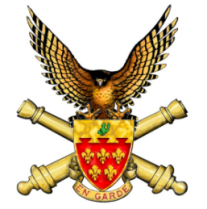
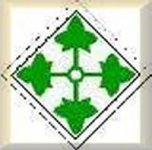
Falcon Logo used Courtesy of Jim Bowers, 77th FA Assn.
Page 11 The Battle...BURT/Post - Battle and more personal accounts
[Page2] [Page3] [Page4] [Page5] [Page6] [Page7] [Page8] [Page9] [Page10] [Page11] {Page12] [BACK TO HISTORY]
From TLN - Jan 29, 1968- Unknown Author,first Photos by SP4 William Fix
Editing Assistance, and Information Previously unknown and not recorded on this site by James Nelson, Of C/2/22 (M)Including this opener. Jim was there to "Kick off" FSB BURT.Here are some of his comments - "As the new 3d Brigade Draftsman, two clerks and I were to sent to FSB BURT by the HQ. Company First sergeant and told to start digging a command bunker. We took shovels, picks, and extra ammunition. I told the clerks, 'we are all alone and being watched, so dig a U-shaped foxhole fast.'Soon, Artillery began prepping the perimeter and we were lifted out later in the day. After finding out about the battle, I returned as soon as I could get a helicopter ride. I arrived at the scene shortly before the battle ended;the idea for this painting was formed then."(the painting which was the source of the photo Shown below,depicts the actual battle 'in progress' so to speak)More specifics will likely be forthcoming. Thanks James.
The Battle Of Soui Cut Is Over - For Some The Memory Lingers
This section is courtesy of c/3/22 website, and it is a more specific account, and has mention of the 2/22 (M) It is by CPT Jerry Brown, Bn Adjutant, so some of it is from his perspective, and there are interviews of the 3 Company commanders. Fairly detailed and informative.However, I'm sure readers will note the conflicts, including portions of the 1st paragraph. -'Nuff said.
3D BATTALION 22D INFANTRY
DEPARTMENT OF THE ARMY
HEADQUARTERS, 3D BATTALION, 22D INFANTRY
APO San Francisco 96268
SUBJECT: Major Action After Action Report
TO: Commanding Officer
3d Brigade, 25th Infantry Division
ATTN: S-3
APO San Francisco 96268
1.On 1 January 1968, at approximately 2330 hours, 3-22 Infantry received a heavy ground and mortar assault from an estimated reinforced VC regiment while securing FSB BURT vicinity XT499806.
2.Events leading up to the mass night attack began on 31 December 1967. At approximately 2130 hours, Company Commander of Company A reported that one of his LP’s, approximately 200 meters out from the perimeter, saw movement near its position. A 16, on perimeter reported movement to its front. The A 16 line detonated three (3) or four (4) Claymore mines. The LP requested permission to return due to VC movement all around its position. A 6 denied request. Both the LP and A 16 element threw two hand grenades, the LP putting their grenades between themselves and the perimeter. Movement stopped for the remainder of the night.
3.The next morning, 1 January 1968, at 0730 hours, Company A made a sweep from their perimeter to the LP position. They discovered two (2) dead VC, one (1) was an officer with a Russian made pistol, and a search of the body resulted in documents including 82mm mortar firing tables. At 0800 hours, the Company A sweep found one (1) wounded VC from the same group and one (1) M-16 US rifle. Results upon questioning the wounded POW and document read-out, found that the dead officer was from the 271st or 272nd VC Main Force Regiment and to that the group was most likely a recon party to include the Forward Observer. The size of the recon party was unknown, but believed to be more than just the three found, due to extensive blood trails leading from impact point of grenade.
4.At approximately 1830 hours, 1 January 1968, a Company A LP reported movement to its front in the fairly thick jungle. Falcon 3 was notified and ordered a sweep of the area. Company Commander of Company A said that his ambush patrol was preparing to leave the perimeter, so they would sweep the area on their way to the ambush site. At 1845 hours, the ambush patrol received S/A fire when they were approximately 200 meters east of the company perimeter, from an unknown VC force resulting in two (2) US KIA and (1) US WIA. The patrol returned to the perimeter and the LP followed. It was 1905 hours and too dark for the ambush to move out. However the LP returned to a different position. Between 2000 hours, and 2030 hours, the Battalion perimeter received 15 60mm mortar rounds which landed inside the perimeter behind and near Company B reserve and behind Battalion Command Group. After the mortar attack Company A CO reported personnel manning one of his bunkers had left their position for an unknown reason. Falcon 3 was notified and told A 6 to get the three men back into position. Two (2) of the former occupants returned, but did not enter the bunker because of a noise inside. The third occupant could not be found. Bunker was surrounded to listen to sounds inside, but not entered due to the possibility of VC occupancy. No firing was done or grenades thrown into the bunker due to the possibility that US personnel might be inside. The name of the third man was called several times but no response. In the morning it was found to be the missing US personnel.
5.During the hours 2030 – 2300, LP’s of both Company A and C and Company B AP reported movement around their positions. At 2330 hours, 60mm mortars began coming in heavily. Approximately 200 rounds fell until 2345 hours, when perimeter saw movement and elements from Fullback and Falcon on the south part of perimeter opened fire. At 0001 hours, Company B ambush patrol on west side of road, north of perimeter (see Enclosure 1) reported heavy movement to its front and to the west. Company C ambush patrol reported heavy movement past its position. Neither patrol initially sprung its ambush due to the overwhelming VC force moving past.
6.The main force of the attack began at approximately 0001 hours, beginning at the northern portion of the perimeter. The main force moved down the west side of the road and peeled off to the portion of the perimeter occupied by 2-22 Infantry (M) with only a small force attacking one platoon of Company B, 3-22 Infantry on the east side of the road. Almost simultaneously a heavy attack of RPG’s, machine guns and small arms opened up on the southern portion of the perimeter along the road. The heaviest force peeled to the east attacking Company C while a smaller assault element moved to the west toward the element of the 2-22 Infantry (M) on the west side of the road. The attack from the south followed the road, the majority of the attackers moving along the ditches which paralleled the road on both sides. Within minutes, a large force opened up with RPG’s, machine guns, small arms, and grenades at the eastern perimeter, attempting to penetrate the company perimeter. The VC continued to cover their attack with 60mm mortar fire. All US personnel not occupying LP or ambushes were defending from sandbagged bunkers with overhead covers.
7.Between 0100 to 0230 hours, 105mm Beehive direct fire was requested and fired along Company C perimeter. VC had penetrated a portion of Company C perimeter at approximately 0200 hours. Beehive rounds eliminated penetration except for four (4) VC. From 0230 to 0400 hours, direct fire from 105mm artillery across Company C perimeter, firing Beehive until expended, then firing HE direct. Company A was reinforced by direct fire across its perimeter from 155mm artillery. At 0200 hours, Company A lost radio communications with its 16 element and two (2) or three (3) VC penetrated the perimeter. At 0300 hours, 2 platoons of Company B (reserve) were committed to reinforce and hold Company A perimeter. From 0445 to 0500 hours, Reconnaissance Platoons was committed to reinforce Company C, who had sustained slight penetration. Recon Platoon could not reinforce previous to this because constant direct fire of Beehive rounds prevented any movement in that area. At 0330 hours, one (1) APC from 2-22 Infantry (M) perimeter was moved to reinforce Company C from rear, and a second APC was placed at 0430 hours. Between 0230 hours and 0330 hours, air strikes were placed on area to the southeast in front of Company C perimeter employing both napalm and CBU.
8.At approximately 0230 hours, Company C ambush reported that 50% of its personnel were casualties. At the time one (1) was KIA from RPG, and several were wounded. In the morning, it was determined that of the 16 men ambush, there had been 1 KIA, 11 WIA from enemy fire and 1 KIA due to the close air support.
9.Fierce close in fighting continued until approximately 0500 hours, when the VC began to withdraw leaving behind their dead and wounded. By 0630 hours, the fighting had nearly stopped with only occasional sniper and some automatic weapons fire. Estimated enemy casualties after early morning sweep near perimeter, 105 VC KIA (BC), 2 VC (PW). Undetermined number of VC individual and crew served weapons. US losses, 16 KIA, 99 WIA. The enemy size and units were not determined exactly, however, it was fairly certain that the size of the force was at least a reinforced regiment with elements from the 271st and 272nd VC Regiments positively identified both from documents and PW interrogation.
End of AAR By CPT. Jerry brown
Battle of Soui Cut, 31 Dec.1967 - 2 Jan. 1968
INTERVIEW: Capt. Elliott Fishburne, 095910, Commanding Officer Company C.
Question: What took place during the early portion of the evening from about dark until 2030 hours on 1 Jan 68?
Answer: I had placed a 3 man LP in front of each platoon perimeter area with a radio about 75 meters out. The ambush was about 350 meters to the southeast. The few incoming mortar rounds around 2000 hours was not anticipated as anything more than harassment since we had been mortared lightly nearly every night for the last three days or so.
Question: Then there was no activity until 2330?
Answer: Everything was quiet until 2330 hours. At this time the heavy mortar attack took place and all LP’s and the AP reported movement all over the place. We had maintained our 100% alert since the earlier attack and every one was in his bunker. The LP’s requested to withdraw but I refused at this time. At about 2345 hours, the entire perimeter opened up and the heavy ground assault started. I recalled the LP’s but the 26 and 36 were unable to return because of the intense fire from the perimeter.
Question: What warning did you have of the eminence of the attack?
Answer: The first we knew of the assault was the reports of heavy movement near the LP’s. Then the VC opened up with dozens of RPG rounds at the bunkers before they tried to penetrate the perimeter. By 0030 hours, the VC were swarming all over the 3rd and 4th platoon bunkers, the second platoon perimeter had no radio (1 was on LP, the other on AP) so the first Platoon leader kept me informed of their situation.
Question: Did they actually get through your perimeter?
Answer: One VC managed to get on top of my CP bunker and was trying to put grenades through the opening. My third platoon leader attempted to get him but was wounded along with 2 others before they got to him. The 105 mm behind my CP got him off with a direct hit from a Beehive. The First platoon reported some VC behind them but very few. The Third platoon reported hand to hand fighting on the southeastern portion of the perimeter which was getting hit hard. One RPG Team took over one bunker.
Question: Describe the employment of Beehive and direct fire.
Answer: The 105 mm right behind my CP began firing Beehive about 0030 at the bunker line and just in front to keep the VC out of the perimeter. It was very effective and kept the VC from over running the southeastern portion of the perimeter. About 0230 hours, all the Beehive was expended and the crew fired HE direct fire. At 0400 hours, the artillery was re-supplied with Beehive and continued to fire them until the attack slowed and eventually contact was broken heavily about 0530.
Question: What other supporting forces did you have?
Answer: We got air strikes with CBU and napalm about 0230 hours, which was very timely and effective. The planes placed their ordinance between my perimeter and the LP’s. Some of the bombs hit within 15 meters of the bunker line. It was extremely accurate and as far as I knew no one on the perimeter was casualty as a result, although I had one (1) KIA on the AP from the air strike. The Puff could not get close enough to do much more than drop flares. The helicopter gun ships arrived about 2 hours late. I don’t know why they were so late. They gave good support with their weapons when they got there however. I also moved two (2) APC’s up behind by perimeter for additional ground support.
Question: What happened to the AP?
Answer: Earlier, about 0230 hours, they reported that half of them were casualties. Later I found that they had exchanged fire with the VC who used RPG’s and automatic weapons. Eleven (11) of them were wounded, one (1) was KIA by an RPG, and one (1) was KIA by the air strike. Only 3 got away without being hurt.
Question: What were the casualties, both sides?
Answer: In the morning our company didn’t make the sweep. Manchu (4th-9th Inf.) did that. However, we counted 53 VC bodies within 30 meters of the bunker line. Only the one on my CP had actually gotten through. I had 12 KIA and 46 WIA.
INTERVIEW: Capt. Herbert Chancy, 05321797, Commanding Officer, Company A.
Question: Where did your principal attack come from?
Answer: We were attacked straight from the east at the extreme right of my perimeter. It was fairly heavy, especially with RPG fire.
Question: Were you penetrated?
Answer: Around 0200 hours, 2 or 3 VC got through just about the time I lost radio contact with 16 on that side. Bravo Company’s reserve force of two platoons filled in the gap in that portion of the perimeter and it was held. Eventually commo was re-established.
Question: What artillery did you have?
Answer: Since the 105mm was firing in support of Company C, we took the only thing we could get which was a 155mm gun. It fired direct fire just over our bunkers and the HE cleared out many of the VC that might otherwise have gotten through.
Question: What was one of your effective defenses?
Answer: We fired all our 90mm RR canister rounds and blew well over 50 claymore mines. My LP blew one claymore mine after which they found 10 dead VC lined up in front of it the next morning.
Question: How did the LP’s communicate?
Answer: I had radio with two of them all night; I lost commo with one LP.
Question: What were your casualties?
Answer: We didn’t make the morning sweep, so we could only count what was within 30 meters of the position. There were 21 VC KIA (BC); I had 4 KIA and 23 WIA.
INTERVIEW: Capt. Robert Hemphill, Commanding Officer, Company B.
Question: What was your mission?
Answer: I only had one platoon on the perimeter. One platoon was an AP on the road and two were reserve.
Question: When did the AP first spot the VC moving south?
Answer: About 2330 hours they reported large numbers of VC moving toward us and didn’t think it was wise to engage them because of the numbers.
Question: Did they ever fire?
Answer: During the night the VC kept moving back and forth past them. Eventually they were compromised and triggered the ambush killing 4 VC. In the morning a heavy blood trail was found indicating that 1 or 2 others were seriously wounded.
Question: When were you called to reinforce A Company?
Answer: About 0300 hours I got word that the VC had broken through A Company’s perimeter so I sent my two reserve platoons who filled in the gap and held the perimeter intact.
Question: What were casualties both sides?
Answer: I had 1 KIA and 21 WIA. We counted 4 VC in front of the AP and in front of the bunkers on the north.
OBSERVATIONS AND LESSONS LEARNED:
1.The well built bunker, utilizing a deep foxhole with heavy overhead cover contributed to the ability of the positions to withstand countless mortar rounds, RPG hits and small arms fire.
2.The employment of direct fire from artillery, the HE and especially the Beehive proved invaluable in the support of the perimeter and prevented the VC from breaking through the perimeter due to sheer force of numbers.
3.Claymores in front of bunkers were a valuable defense.
4.LP’s proved to be the only early warning of the size and eminence of the attack.
5.In the Company C area the VC were too close to positions and Beehive was so intense that the 90’s could not be fired.
6.Air strikes and the precision of the bombs kept the majority of the attackers from getting close enough to attack with as great a capability as their numbers could have had the capacity for doing.
7.Gun ships arrived too late to turn the initial attack.
8.Artillery and Puff furnished good flare support since illumination was vital for defense.
This section is basically two more perspectives. The first is a brief account.
The second is also brief but deals specifically with the Brave deeds of C/2/22 Inf. and C/2/22 Recon. An interesting side note - to me anyway, and this is my Taco stand - gave me a dark humor thought, as I had a similar circumstance on RATT team's way up to Burt. James applied and got the nod for Brigade drafter. Shortly - a first Sergeant, or maybe sergent major, comes to him and says saddle up, you are goin out to Burt, and you are to lay out the Bunker that will house the Brigade TOC. Ok, so far - so good. FAST FORWARD - might have been something like "What the hell you mean, this is it??!! There's nothin here!" while the pilot was pulling pitch, and yelling this is it they'll be along directly or something similar. Well, they began trying to dig in that hard ground, and lookin around for you know who! Preferably the you know whos in tracks or helicopters! Well while James and his side kick were undoubtedly having some pretty scary "daymares" they FINALLY came! WHEW! RIGHT?? That is the closest thing I could get from him as far as a Burt story, about him. But most of the Tiger Patrol info and info about Lt. Kelley and Sgt Ridley came from him.
3RD BDE -It was just getting dark when the Viet Cong started mortaring Fire Support Base Burt. The Viet Cong had been doing the same thing at the same time for the past few nights, so it wasn't anything new to the men of the 3rd Bde who were defending the forward base camp at Soui Cut.
As the hours started to slip by, the defenders knew that this was more than their nightly mortar attack. They started receiving RPG rounds and small arms fire along with the mortar rounds. The ambush patrols were reporting heavy movement around their positions. As the contact became heavier the patrols were being pulled back into the perimeter. At 11:30 p.m. the perimeter was under very heavy ground attack. All patrols that had not returned to the perimeter at this time were reporting that their positions were in danger of being overrun by the enemy.According to James Nelson, also at the battle,One patrol'TIGER PATROL' - 1st Platoon, C/2/22 (Mech), Led by lT.Gordon Kelley,SGT Mark Ridley and the rest of the patrol took up a position in a Crater,laying low. While Lt. Kelley went back to the berm that was part of the perimeter, Northwest betweeen the crater and defensive positions of the rest of C/2/22. He took an M-60 and likely ammo bearer, and from there, apparently help the contingent of troops who also set up their Automatic weapons, and M-79s to continue the fight after their Track was disabled.This while Lt. Kelley was also calling in very accurate Air Strikes of napalm and CBU. Meanwhile, likely on orders, Sgt Ridley was calling in concentrated artillery fire on his position. Likely from the nearby support FSB Beauregard. the patrol which stayed in its position all night accounted for 16 of the Viet Cong killed. I think I heard that Ridley,and the other members of the patrol, after being discovered and forced to defend themselves, fired, and threw grenades into the advancing enemy all night. Kelley and Ridley, were Just 2 Different Heros,guiding 2 different types of support usually done on 2 different troops on 2 different Frequencies, or "Pushes" to save the other many Heros doing their jobs, and sometimes more, and the rest of the Tiger Patrol with small arms, like M-16s, M-79,and hand Frag grenades,likely enabling them to concentrate more fully, and do their mission better. A great team, of heros, no doubt.
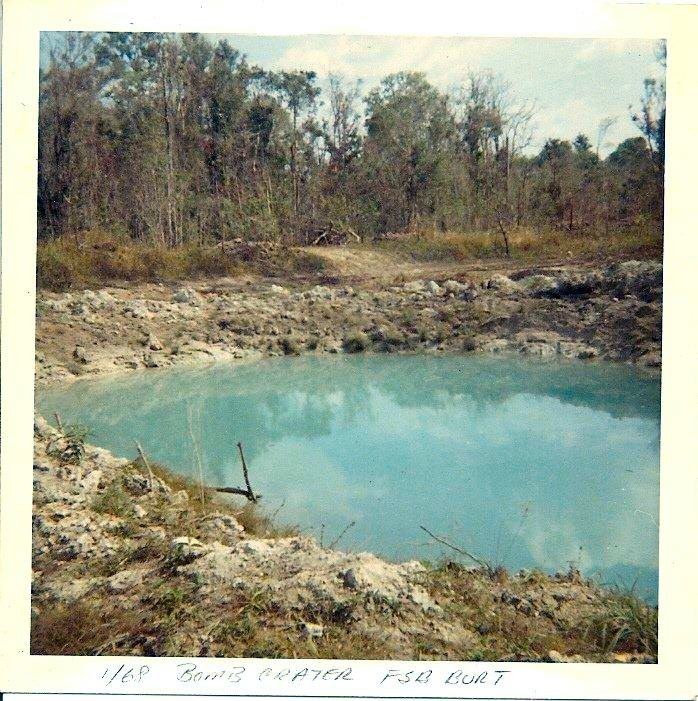
Above - Ken Simpson's (Focus Charlie 5) pic of the B52 crater Tiger Patrol's Defense Position the morning After
At 1:30 a.m. the main Viet Cong effort had shifted to the sector of C Co, 2nd Bn (Mech), 22nd Inf. The Viet Cong elements had succeeded in reaching the bunker line but their progress was thwarted when the guns of the light artillery started firing and the heavy artillery started firing direct fire into their positions. The attack at this point was broken and contact slackened.
Again after regrouping their forces the Viet Cong attacked the same sector. Their fires increased and all areas of the perimeter were engaged. As the Viet Cong directed their fire to one concentrated area all tactical air, along with artillery, direct and indirect fire, gun and flare ships were being employed to stop the attack.
When it started getting daylight the Viet Cong started to withdraw leaving blocking forces to screen their movement. All available fire continued to interdict their withdrawal routes.
As the dawn of the new day broke it was obvious that the men of the 3rd Bde had put out a tremendous amount of fire power. The surrounding wood line had been all but completely leveled. After scanning the immediate area of the fire support base it was obvious that the Viet Cong body count was going to be high. By the end of the day the body count was at 300. With a further search of the adjoining jungle and wood line the count increased to over 400 dead. Of course many more will never be found to add to the official count.
Just as the 3rd Bde proved itself eight months ago at the Battle of Soui Tre, again they gallantly outfought the Viet Cong at the Battle of Soui Cut at Fire Support Base Burt.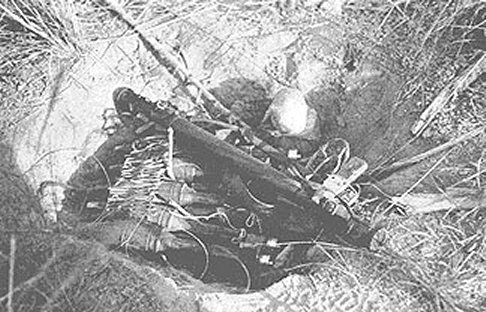
ABOVE: Rpg Rounds discovered by 322 "Falcon" Inf. After the battle.
BELOW: Lt. Keprerer examining an RPG launcher found after.
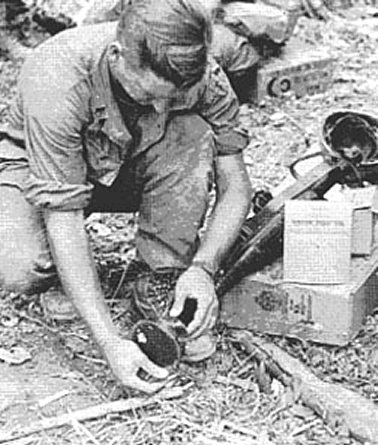
3RD BDE - Aggressively reacting to key points on the perimeter, the reconnaissance platoon of the 2nd Bn (Mech), 22nd Inf,"Fullback" played a key role in the defense of Fire Support Base Burt during the attack on the night of Jan. 1-2. Several times that night, elements of the recon platoon who were not already on the line, were called to critical portions of the perimeter to provide the additional firepower necessary to drive back the Viet Cong attackers.
Alerted to react at the start of the main attack, the recon platoon mounted their "tracks" and prepared for action. Shortly after midnight three tracks were dispatched to support Charlie Co, who was in heavy contact with the enemy on the southern portion of the perimeter. The recon elements moved swiftly down the road that bisected FSB Burt directly into the face of the enemy who had already reached the bunker line on the perimeter. Laying down a heavy base of fire with M-60 and .50 cal. machine guns and M-79 grenade launchers, they drove the enemy back into the woodline.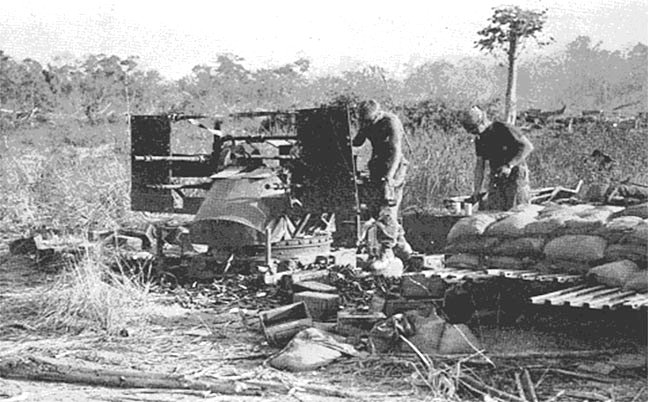 A second time the Viet Cong poured out of the woods against the combined recon-Charlie Co positions firing RPGs and small arms. Although two of the recon vehicles and one of Charlie Co's were put out of action, the men, led by 1LT Erhard Opsahl, set up their automatic weapons and M-79s on a berm behind the destroyed tracks and maintained intense fire on the enemy, pushing them back into the jungle where they were finally destroyed by artillery beehives and air strikes.
Shortly after the first three tracks were sent to Charlie Co, more recon tracks were dispatched to bolster Bravo Co, who was heavily engaged with the enemy on the opposite end of the base from Charlie Co. Recon track 74, commanded by SGT William Storey, assumed a position where it could deliver its firepower directly upon the Viet Cong who were advancing down the road toward the base from the north. The track poured forth a heavy volume of fire against the enemy, despite sustaining two direct RPG hits, until finally the entire crew of the vehicle fell wounded.
A second time the Viet Cong poured out of the woods against the combined recon-Charlie Co positions firing RPGs and small arms. Although two of the recon vehicles and one of Charlie Co's were put out of action, the men, led by 1LT Erhard Opsahl, set up their automatic weapons and M-79s on a berm behind the destroyed tracks and maintained intense fire on the enemy, pushing them back into the jungle where they were finally destroyed by artillery beehives and air strikes.
Shortly after the first three tracks were sent to Charlie Co, more recon tracks were dispatched to bolster Bravo Co, who was heavily engaged with the enemy on the opposite end of the base from Charlie Co. Recon track 74, commanded by SGT William Storey, assumed a position where it could deliver its firepower directly upon the Viet Cong who were advancing down the road toward the base from the north. The track poured forth a heavy volume of fire against the enemy, despite sustaining two direct RPG hits, until finally the entire crew of the vehicle fell wounded.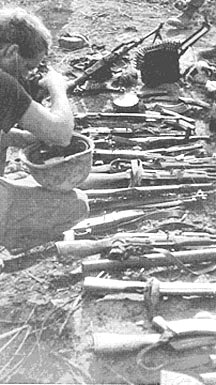 Had the recon platoon failed to react quickly enough, part of the southern perimeter might well have been overrun, greatly endangering the guns of the artillery directly behind the line. As it was, the aggressive response of the "Triple Deuces" recon platoon played a great part in the tremendous victory achieved by the 3rd Bde at Fire Support Base Burt in the Battle of Soui Cut.
Had the recon platoon failed to react quickly enough, part of the southern perimeter might well have been overrun, greatly endangering the guns of the artillery directly behind the line. As it was, the aggressive response of the "Triple Deuces" recon platoon played a great part in the tremendous victory achieved by the 3rd Bde at Fire Support Base Burt in the Battle of Soui Cut.
 Above - Didn't even know till recently that it was Westy I saw with all those stars that made me think "Star Guy" when I saw
Him out of the corner of my eye, sitting down at breakfast of honest to GOD REAL, HAM, BACON, AND EGGS AND ALL THE OTHER Great stuff!! I think there were even fried potatos and Gravy.I had Graves Registration Detail, part of it, so I was in a hurry.
Above - Didn't even know till recently that it was Westy I saw with all those stars that made me think "Star Guy" when I saw
Him out of the corner of my eye, sitting down at breakfast of honest to GOD REAL, HAM, BACON, AND EGGS AND ALL THE OTHER Great stuff!! I think there were even fried potatos and Gravy.I had Graves Registration Detail, part of it, so I was in a hurry.
[Page2] [Page3] [Page4] [Page5] [Page6] [Page7] [Page8] [Page9] [Page10] [Page11][Page12] [BACK TO HISTORY]









 A second time the Viet Cong poured out of the woods against the combined recon-Charlie Co positions firing RPGs and small arms. Although two of the recon vehicles and one of Charlie Co's were put out of action, the men, led by 1LT Erhard Opsahl, set up their automatic weapons and M-79s on a berm behind the destroyed tracks and maintained intense fire on the enemy, pushing them back into the jungle where they were finally destroyed by artillery beehives and air strikes.
Shortly after the first three tracks were sent to Charlie Co, more recon tracks were dispatched to bolster Bravo Co, who was heavily engaged with the enemy on the opposite end of the base from Charlie Co. Recon track 74, commanded by SGT William Storey, assumed a position where it could deliver its firepower directly upon the Viet Cong who were advancing down the road toward the base from the north. The track poured forth a heavy volume of fire against the enemy, despite sustaining two direct RPG hits, until finally the entire crew of the vehicle fell wounded.
A second time the Viet Cong poured out of the woods against the combined recon-Charlie Co positions firing RPGs and small arms. Although two of the recon vehicles and one of Charlie Co's were put out of action, the men, led by 1LT Erhard Opsahl, set up their automatic weapons and M-79s on a berm behind the destroyed tracks and maintained intense fire on the enemy, pushing them back into the jungle where they were finally destroyed by artillery beehives and air strikes.
Shortly after the first three tracks were sent to Charlie Co, more recon tracks were dispatched to bolster Bravo Co, who was heavily engaged with the enemy on the opposite end of the base from Charlie Co. Recon track 74, commanded by SGT William Storey, assumed a position where it could deliver its firepower directly upon the Viet Cong who were advancing down the road toward the base from the north. The track poured forth a heavy volume of fire against the enemy, despite sustaining two direct RPG hits, until finally the entire crew of the vehicle fell wounded. Had the recon platoon failed to react quickly enough, part of the southern perimeter might well have been overrun, greatly endangering the guns of the artillery directly behind the line. As it was, the aggressive response of the "Triple Deuces" recon platoon played a great part in the tremendous victory achieved by the 3rd Bde at Fire Support Base Burt in the Battle of Soui Cut.
Had the recon platoon failed to react quickly enough, part of the southern perimeter might well have been overrun, greatly endangering the guns of the artillery directly behind the line. As it was, the aggressive response of the "Triple Deuces" recon platoon played a great part in the tremendous victory achieved by the 3rd Bde at Fire Support Base Burt in the Battle of Soui Cut.
 Above - Didn't even know till recently that it was Westy I saw with all those stars that made me think "Star Guy" when I saw
Him out of the corner of my eye, sitting down at breakfast of honest to GOD REAL, HAM, BACON, AND EGGS AND ALL THE OTHER Great stuff!! I think there were even fried potatos and Gravy.I had Graves Registration Detail, part of it, so I was in a hurry.
Above - Didn't even know till recently that it was Westy I saw with all those stars that made me think "Star Guy" when I saw
Him out of the corner of my eye, sitting down at breakfast of honest to GOD REAL, HAM, BACON, AND EGGS AND ALL THE OTHER Great stuff!! I think there were even fried potatos and Gravy.I had Graves Registration Detail, part of it, so I was in a hurry.